
151 Results


This learning module (Lesson 3 of Unit 1) is part of a course called Project Management Fundamentals and may either be completed individually as a stand-alone topic, or part of a trio of introductory learning modules, or as part of the course.This learning module consists of an experiential exercise called the Rock'n Bands game by Klassen & Willoughby (2003) where students engage in a simulated project management exercise.
- Subject:
- Management
- Material Type:
- Lesson
- Author:
- Paul Szwed
- Date Added:
- 08/14/2023
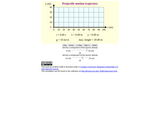
This simulation is about Projectile Motion set initial velocity components
هذه المحاكاة تتعلق بحركة المقذوفات - وآلية تحديد مكونات السرعه الأولية.
- Subject:
- Physical Science
- Physics
- Material Type:
- Simulation
- Provider:
- Boston University
- Author:
- Andrew Duffy
- Date Added:
- 12/22/2016
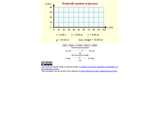
This simulation is about Projectile Motion set speed and angle. هذه المحاكاة تتعلق بحركة المقذوفات - السرعه والزاوية
- Subject:
- Physical Science
- Physics
- Material Type:
- Simulation
- Provider:
- Boston University
- Author:
- Andrew Duffy
- Date Added:
- 12/22/2016
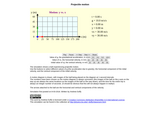
This simulation is about Projectile Motion with motion diagram and velocity components
, هذه المحاكاة تتحدث عن - حركة المقذوفات , مع عناصر الرسم البياني الحركة والسرعه.
- Subject:
- Physical Science
- Physics
- Material Type:
- Simulation
- Provider:
- Boston University
- Author:
- Andrew Duffy
- Date Added:
- 12/22/2016

This simulation is about Projectile Motion (with motion diagram, velocity components, and graphs,
هذه المحاكاة هي تتحدث عن حركة المقذوفات ومايتعلق بمخطط الحركة، مكوناته والسرعة، والرسوم البيانية
- Subject:
- Physical Science
- Physics
- Material Type:
- Simulation
- Provider:
- Boston University
- Author:
- Andrew Duffy
- Date Added:
- 12/22/2016
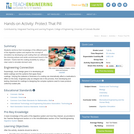
Students reinforce their knowledge of the different parts of the digestive system and explore the concept of simulation by developing a pill coating that can withstand the churning actions and acidic environment found in the stomach. Teams test the coating durability by using a clear soda to simulate stomach acid.
- Subject:
- Anatomy/Physiology
- Applied Science
- Engineering
- Life Science
- Material Type:
- Activity/Lab
- Provider:
- TeachEngineering
- Provider Set:
- TeachEngineering
- Author:
- Denise W. Carlson
- Jacob Crosby
- Malinda Schaefer Zarske
- Todd Curtis
- Date Added:
- 09/18/2014

This simulation is showing the Race between a dropped ball and one launched horizontally هذه المحاكاة توضح الفرق بالسرعه بين كرة سقطت من الأعلى الى الأسفل وبين كرة اطلقت من الأسفل الى الأعلى.
- Subject:
- Physical Science
- Physics
- Material Type:
- Simulation
- Provider:
- Boston University
- Author:
- Andrew Duffy
- Date Added:
- 12/22/2016

This course investigates the principles of thermal radiation and their applications to engineering heat and photon transfer problems. Topics include quantum and classical models of radiative properties of materials, electromagnetic wave theory for thermal radiation, radiative transfer in absorbing, emitting, and scattering media, and coherent laser radiation. Applications cover laser-material interactions, imaging, infrared instrumentation, global warming, semiconductor manufacturing, combustion, furnaces, and high temperature processing.
- Subject:
- Applied Science
- Atmospheric Science
- Career and Technical Education
- Chemistry
- Engineering
- Environmental Science
- Environmental Studies
- Physical Science
- Physics
- Material Type:
- Full Course
- Provider Set:
- MIT OpenCourseWare
- Author:
- Chen, Gang
- Date Added:
- 02/01/2006
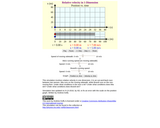
This simulation involves relative velocity in one dimension. It is an out-and-back race between two women. Mia runs on the moving sidewalk, while Brandi runs on the non-moving floor. Under what conditions is the race a tie? Under what conditions does Mia win? Under what conditions does Brandi win?
- Subject:
- Physical Science
- Physics
- Material Type:
- Simulation
- Provider:
- Boston University
- Author:
- Andrew Duffy
- Date Added:
- 12/22/2016
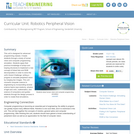
This unit is designed for advanced programming classes. It leads students through a study of human vision and computer programming simulation. Students apply their previous knowledge of arrays and looping structures to implement a new concept of linked lists and RGB decomposition in order to solve the unit's Grand Challenge: writing a program to simulate peripheral vision by merging two images. This unit connects computer science to engineering by incorporating several science topics (eye anatomy, physics of light and color, mathematics, and science of computers) and guides students through the design process in order to create final simulations.
- Subject:
- Applied Science
- Education
- Engineering
- Material Type:
- Full Course
- Unit of Study
- Provider:
- TeachEngineering
- Provider Set:
- TeachEngineering
- Author:
- Anna Goncharova
- Date Added:
- 09/18/2014
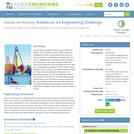
In a simulation of potential future space missions to Europa, one of Jupiter’s moons, student teams are challenged to direct a robot placed in an enclosed maze to search for and find the most “alien life.” The robot is equipped with a camera to send a live feed of its surroundings in the maze. Students control the robot from outside the maze by looking at the live feed on a smartphone and using the robot’s remote control, making a map as they go. The student teams compete as if they are space agencies creating their own exploratory systems to meet the challenge’s criteria and constraints and prove “in the field” that they have the best plan to win the mission contract and get the job. This activity simulates the real-world research of scientists and engineers developing a robot with the capabilities to explore under the ice-covered surface of Europa.
- Subject:
- Career and Technical Education
- Physical Science
- Material Type:
- Activity/Lab
- Provider:
- TeachEngineering
- Author:
- Anthony Spears
- Ayanna Howard
- Carrie Beth Rykowski
- Date Added:
- 02/07/2017
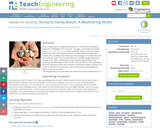
Given a hypothetical civil engineering scenario, student pairs are tasked to apply their knowledge of the rock cycle, rock types, rock weathering and the engineering design process to model a potential method to create a sandy beach from three rocky island shorelines. For their abrasion weathering models, they use wide-mouth lidded jars and three types of candies that serve as the testing “rocks.” They simulate both low- and high-energy weathering environments. After completing the simple weathering techniques and analyzing their observations of the results, they conclude by recommending to the island developer which rocky shoreline would be the easiest, simplest, and most cost-effective from which to create a sandy beach. A worksheet and pre/post quiz are provided.
- Subject:
- Physical Science
- Material Type:
- Activity/Lab
- Provider:
- TeachEngineering
- Provider Set:
- Activities
- Author:
- Michael Herbst
- Wyatt Whiteaker
- Date Added:
- 06/09/2017
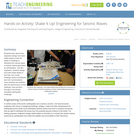
Students learn about how engineers design and build shake tables to test the ability of buildings to withstand the various types of seismic waves generated by earthquakes. Just like engineers, students design and build shake tables to test their own model buildings made of toothpicks and mini marshmallows. Once students are satisfied with the performance of their buildings, they put them through a one-minute simulated earthquake challenge.
- Subject:
- Applied Science
- Architecture and Design
- Engineering
- Material Type:
- Activity/Lab
- Provider:
- TeachEngineering
- Provider Set:
- TeachEngineering
- Author:
- Carleigh Samson
- Denise W. Carlson
- Stephanie Rivale
- Date Added:
- 09/18/2014
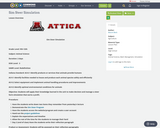
Sim Steer Simulation Grade Level: 9th-12thSubject: Animal ScienceDuration: 2 daysDOK Level: 3SAMR Level: Redefinition Indiana Standard: AS-8.1 Identify products or services that animals provide humansAS-9.1 Identify facilities needed to house and produce each animal species safely and efficiently AS-9.2 Select equipment and implement animal handling procedures and improvements AS-9.3 Identify optimal environmental conditions for animalsObjective: Students will apply their knowledge learned in the unit to make decision and manage a steer farm simulation that earns a profit.Procedure: Have the students write down two items they remember from yesterday's lectureDemonstrate the Sim Steer ProgramHave the students access the website/program and create a user accountHand out the project guidelines Explain the expectations and timelineAllow the rest of the time for the students to manage their herdDay 2 (end of class) Have the students write their reflection paragraphProduct or Assessment: Students will be assessed on their reflection paragraphs
- Subject:
- Agriculture
- Material Type:
- Lesson Plan
- Author:
- Macon Beck
- Date Added:
- 07/14/2017
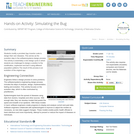
Students modify a provided App Inventor code to design their own diseases. This serves as the evolution step in the software/systems design process. The activity is essentially a mini design cycle in which students are challenged to design a solution to the modification, implement and test it using different population patterns The result of this process is an evolution of the original app.
- Subject:
- Applied Science
- Computer Science
- Engineering
- Material Type:
- Activity/Lab
- Provider:
- TeachEngineering
- Provider Set:
- TeachEngineering
- Author:
- Douglas Bertelsen
- Date Added:
- 09/18/2014
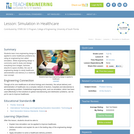
Students learn how engineering design is applied to solve healthcare problems by using an engineering tool called simulation. While engineering design is commonly used to study and design everything from bridges, factories, airports to space shuttles, the use of engineering design to study healthcare administration and delivery is a relatively new concept.
- Subject:
- Applied Science
- Engineering
- Health, Medicine and Nursing
- Material Type:
- Lesson Plan
- Provider:
- TeachEngineering
- Provider Set:
- TeachEngineering
- Author:
- Courtney Feliciani Patricio Rocha
- Dayna Martinez
- Tapas K. Das
- Date Added:
- 09/18/2014
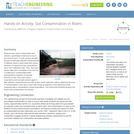
Students learn about contamination and pollution, specifically in reference to soil in and around rivers. To start, groups use light sensors to take light reflection measurements of different colors of sand (dyed with various amounts of a liquid food dye), generating a set of "soil" calibration data. Then, they use a stream table with a simulated a river that has a scattering of "contaminated wells" represented by locations of unknown amounts of dye. They make visual observations and use light sensors again to take reflection measurements and refer to their earlier calibration data to determine the level of "contamination" (color dye) in each well. Acting as engineers, they determine if their measured data is comparable to visual observations. The small-scale simulated flowing river shows how contamination can spread.
- Subject:
- Applied Science
- Engineering
- Environmental Science
- Material Type:
- Activity/Lab
- Provider:
- TeachEngineering
- Provider Set:
- TeachEngineering
- Author:
- Sophia Mercurio
- Date Added:
- 10/14/2015
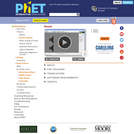
This simulation lets you see sound waves. Adjust the frequency or volume and you can see and hear how the wave changes. Move the listener around and hear what she hears.
- Subject:
- Physical Science
- Physics
- Material Type:
- Simulation
- Provider:
- University of Colorado Boulder
- Provider Set:
- PhET Interactive Simulations
- Author:
- Carl Wieman
- Danielle Harlow
- Kathy Perkins
- Ron LeMaster
- Wendy Adams
- Date Added:
- 10/22/2006
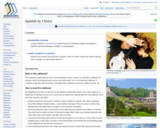
This wikibook is quite different from a normal Spanish course. In fact, it is more like a collection of booklets, which accompany audio courses and audio books. As it is an electronic wikibook, it combines audio files with transcripts, vocabulary lists, interactive exercises, images, forums, etc.
- Subject:
- Arts and Humanities
- Languages
- Material Type:
- Textbook
- Provider:
- Wikibooks
- Author:
- Wikibooks contributors
- Date Added:
- 02/04/2022